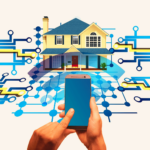Table of Contents
ToggleIntroduction
In recent years, the rise of smart home devices has revolutionized the way we interact with our living spaces. From thermostats to security cameras, these gadgets offer convenience, comfort, and connectivity like never before.
However, along with their benefits come security concerns. How secure are smart home devices, and what measures can we take to protect our privacy and safety?
Types and Categories
Internet of Things (IoT) Devices
The Internet of Things (IoT) encompasses a wide range of devices connected to the Internet, capable of collecting and exchanging data.
In the context of smart homes, IoT devices include smart thermostats, lights, locks, cameras, and appliances. These devices are designed to enhance convenience and efficiency by allowing users to control them remotely via smartphone apps or voice commands.
Network-Connected Gadgets
Smart home devices rely on network connectivity to communicate with each other and with external servers or applications.
They typically connect to home networks via Wi-Fi, Bluetooth, Zigbee, or other wireless protocols. While this connectivity enables seamless integration and automation, it also opens up potential avenues for exploitation by malicious actors.
Weak encryption, unsecured connections, and outdated firmware can all leave smart home devices vulnerable to cyber attacks.
Symptoms and Signs
Unauthorized Access
One of the most concerning security risks associated with smart home devices is unauthorized access. Developers may exploit vulnerabilities in device firmware or network configurations to gain access to these devices remotely.
Signs of unauthorized access may include changes in device settings, unexpected behavior, or the appearance of unknown users on device management interfaces.
Data Breaches
Smart home devices often collect and store sensitive information, such as user preferences, usage patterns, and even audio or video recordings.
A data breach involving smart home devices can have serious consequences for user privacy and security.
They may gain access to this data through various means, including exploiting vulnerabilities in device firmware, intercepting unencrypted communications, or compromising cloud-based servers.
Causes and Risk Factors
Weak Passwords
One of the most common causes of security breaches involving smart home devices is the use of weak or default passwords.
Many users fail to change the default passwords provided by manufacturers, or they choose passwords that are easy to guess.
Weak passwords make it easier for developers to gain unauthorized access to smart home devices and compromise user privacy.
Outdated Software
Like any other electronic device, smart home devices require regular software updates to patch security vulnerabilities and improve performance.
However, many users neglect to update their devices’ firmware or software, leaving them vulnerable to exploitation. Outdated software may contain known security flaws that can be exploited to gain unauthorized access to smart home devices.
Diagnosis and Tests
Vulnerability Assessments
To assess the security of smart home devices, users can conduct vulnerability assessments using specialized tools and techniques.
These assessments involve scanning devices and network infrastructure for known security vulnerabilities and misconfigurations. By identifying and addressing these vulnerabilities, users can reduce the risk of security breaches and unauthorized access to their smart home devices.
Penetration Testing
Penetration testing, also known as ethical, involves simulating cyber attacks against smart home devices to identify potential security weaknesses.
Ethical use of a variety of tools and techniques to probe devices and network infrastructure for vulnerabilities that could be exploited by malicious actors.
Treatment Options
Secure Configuration
One of the most effective ways to improve the security of smart home devices is to configure them securely.
This includes changing default passwords, disabling unnecessary features, and enabling security settings such as encryption and two-factor authentication.
By following best practices for device configuration, users can reduce the risk of unauthorized access and data breaches involving their smart home devices.
Encryption
Encryption plays a crucial role in protecting the confidentiality and integrity of data transmitted between smart home devices and external servers or applications.
By encrypting data using strong cryptographic algorithms, users can prevent unauthorized parties from intercepting or tampering with sensitive information.
It’s essential to use encryption protocols that are robust and resistant to known attacks to ensure the security of smart home communications.
Preventive Measures
Network Segmentation
Segmenting your home network can help prevent unauthorized access to smart home devices by isolating them from other devices and services on the network.
By creating separate network segments or VLANs for smart home devices, users can limit the potential impact of security breaches and contain the spread of malware or malicious activity.
Additionally, using guest networks for IoT devices can further enhance network security by isolating them from trusted devices and services.
Firewalls and Security Software
Installing firewalls and security software on home networks can provide an additional layer of defense against cyber attacks targeting smart home devices.
Firewalls can filter incoming and outgoing traffic, blocking malicious connections and preventing unauthorized access to devices.
Security software such as antivirus programs can detect and remove malware infections on smart home devices, protecting them from compromise by malicious actors.
Personal Stories or Case Studies
Real-Life Security Incidents
Numerous real-life incidents highlight the importance of securing smart home devices against cyber attacks. In one notable case, developers exploited a vulnerability in a popular smart home camera to gain unauthorized access to users’ homes and spy on them remotely.
This incident underscored the potential risks associated with insecure smart home devices and the importance of taking proactive measures to protect against security threats.
Expert Insights
Cybersecurity Experts
Cybersecurity experts emphasize the importance of securing smart home devices against cyber attacks to protect user privacy and security.
They recommend following best practices for device configuration and regularly updating firmware and software. Using strong encryption protocols to safeguard sensitive information.
By taking these steps, users can reduce the risk of security breaches and unauthorized access to their smart home devices.
Conclusion
In conclusion, while smart home devices offer convenience and connectivity, they also present security risks that cannot be ignored. By understanding these risks and taking proactive measures to secure our devices and networks.
We can enjoy the benefits of smart technology without compromising our safety and privacy. Remember to use strong, unique passwords, regularly update firmware and software, enable security features such as encryption, and segment your network to isolate smart home devices from other devices and services.
By following these best practices, you can enhance the security of your smart home environment and protect against cyber threats.
Frequently Asked Questions (FAQs)
Q1: Are smart home devices secure?
Yes, smart home devices can be secure if properly configured and maintained. However, they are susceptible to security risks if not adequately protected.
Q2: What are the common security risks associated with smart home devices?
Common security risks include unauthorized access, data breaches, weak passwords, outdated software, and vulnerabilities in device firmware.
Q3: How can I secure my smart home devices?
You can secure your smart home devices by using strong, unique passwords, regularly updating firmware and software, enabling security features such as encryption, segmenting your network, and using firewalls and security software.
Q4: What should I do if I suspect a security breach?
If you suspect a security breach, immediately disconnect the affected device from the network, change passwords, update firmware/software, and conduct a thorough security assessment.
Q5: Are there any privacy concerns with smart home devices?
Yes, privacy concerns arise from the collection and potential misuse of personal data by smart home devices and their associated services. It’s essential to review privacy policies, limit data sharing, and use devices with built-in privacy protections.
Q6: Is there a risk of smart home devices being compromised?
Yes, smart home devices can be compromised if vulnerabilities are exploited. developers may gain unauthorized access to devices, manipulate settings, or intercept sensitive information. Implementing security measures can mitigate the risk of compromise.
Q7: What role does encryption play in smart home security?
Encryption is crucial for securing data transmitted between smart home devices and their associated apps or servers. It ensures that data remains confidential and cannot be intercepted or tampered with by unauthorized parties.
Q8: How often should I update my smart home devices?
It’s essential to regularly update smart home devices as manufacturers release firmware and software updates to patch security vulnerabilities and improve performance.









